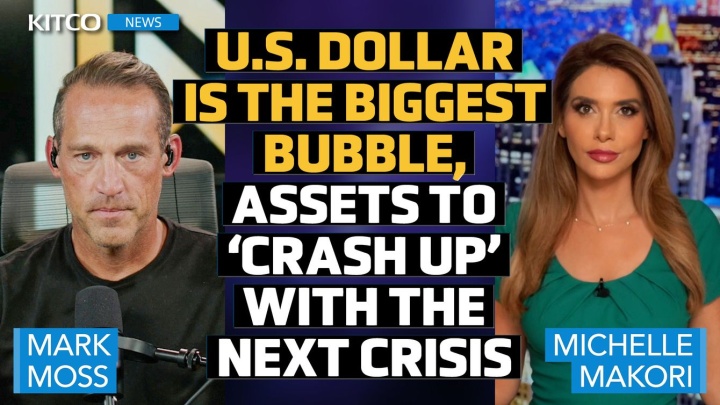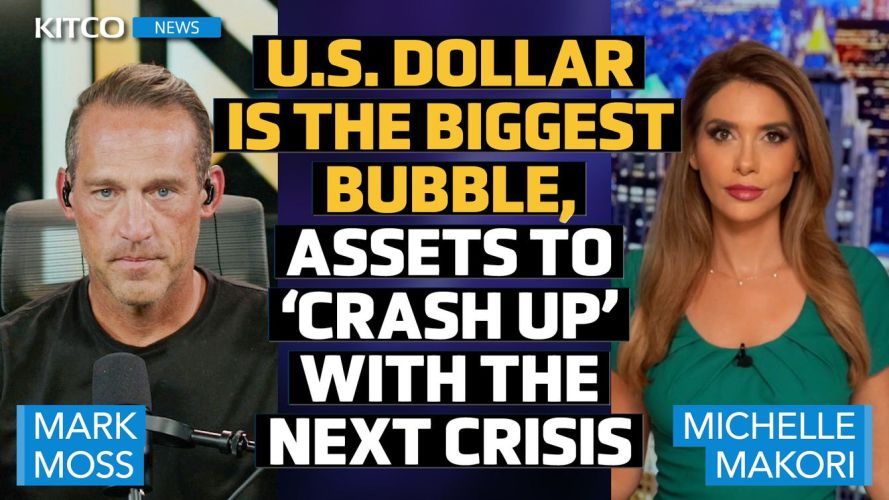
U.S. dollar is 'the biggest asset bubble,' all roads lead to more money printing – Mark Moss

The inevitable consequences of a recession in the U.S. are more money printing, liquidity injections and inflation, according to Mark Moss, Host of 'The Mark Moss Show' and Partner of the Bitcoin Opportunity Fund, who warns that the U.S. dollar is the biggest asset bubble.
"We're in the situation where all roads lead to more government printing and more inflation," Moss told Michelle Makori, Lead Anchor and Editor-in-Chief at Kitco News. "If we were to have a recession, that just means more inflation … The Fed is between the rock and the hard place; there's no way out. The government cannot afford a recession. Typically, when we see a recession, we see tax receipts drop by somewhere between 12 to 15%. They can't afford that."
There's a big difference between a recession and how asset prices perform, Moss noted, saying that the Fed will inevitably inject more liquidity into the economy, causing asset prices to "crash up" due to devaluation and debasement of the U.S. dollar's purchasing power.
For insights on Moss' 'crash up' theory, watch the video above.
He explained that it all comes down to the fact that the U.S. is running on a debt-based monetary system, with the national debt now surpassing $35 trillion.
"Money is created through debt issuance. That means the dollar is a liability, and the debt is an asset. Then, it becomes collateral for more debt. The problem is that if these asset prices start to fall, then there's not enough collateral for the other debt that's out there. And that will cause a massive downward spiral that we could not handle," Moss said.
This cycle ultimately leads to more liquidity injections into the economy, with more money ending up in assets like equities, real estate, Bitcoin, and gold.
“We know that the S&P 500 moves up exactly like the global liquidity,” Moss noted. “Gold has a sensitivity ratio of 1.49. So that means for every 10% rise in liquidity, gold goes up by 14%. Bitcoin has an 8.95 sensitivity, which means for every 10% rise in liquidity, Bitcoin goes up by 90%.”
Moss also pointed out that individuals do not really own anything in a debt-based monetary system. “The money in the bank is legally not your money. That money is owed to you. Stocks – you don't actually own those legally, your broker owes them to you. The house that you've paid off, you don't really own that. You have to pay monthly to the County assessor, or they take that from you,” Moss stated.
Watch the video above for his explanation how the debt-based monetary system works.
Perhaps the biggest issue for investors is the state of the U.S. dollar. Moss stated that as the dollar continues to lose its purchasing power, it creates an illusion of asset price bubbles forming in areas like real estate and stocks. However, the real bubble lies in the dollar's value.
"It's not that stocks are in a bubble or homes are in a bubble. It's the dollars that are in a bubble," he said. "We're looking at the underlying denominator – the U S dollars – a manipulated denominator. We're not realizing the bubble is actually in the denominator – the dollars."
For more on Moss' "dollar is the biggest asset bubble" theory, watch the video above.
What's next for Bitcoin?
If former President Donald Trump wins the election, Moss sees Bitcoin hitting $400k towards the end of 2025. For his more precise timeline and Bitcoin price forecast for the end of this year, the start of 2025, and the longer term, watch the video above for insights.
This video is brought to you by Swan Bitcoin:
Swan Bitcoin IRA – Start Saving Now ð https://Swan.com/retire
Kitco Media
Anna Golubova
Tim Moseley
